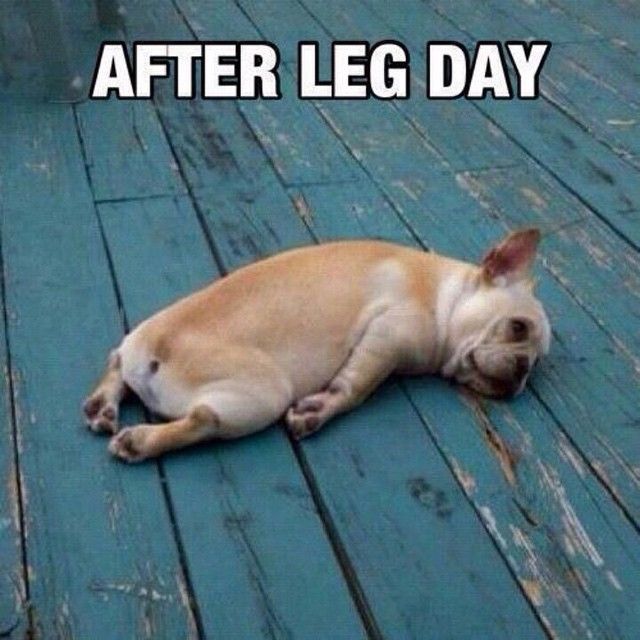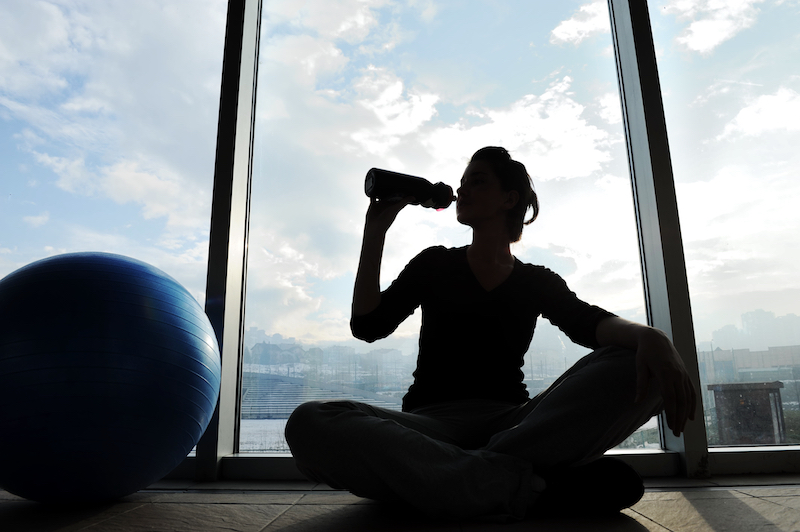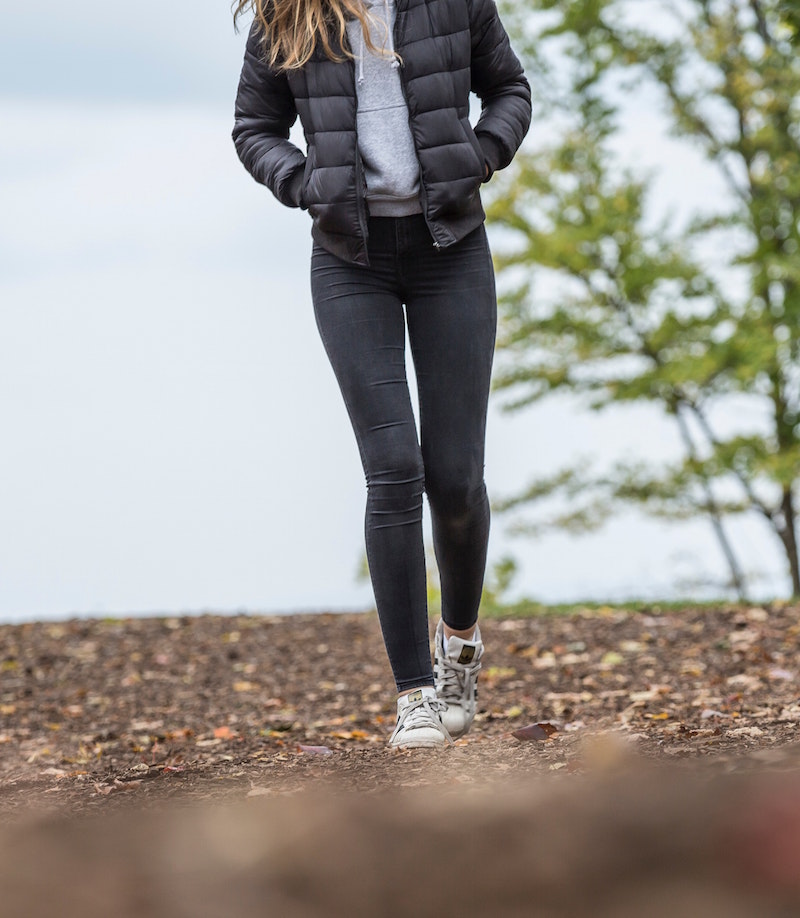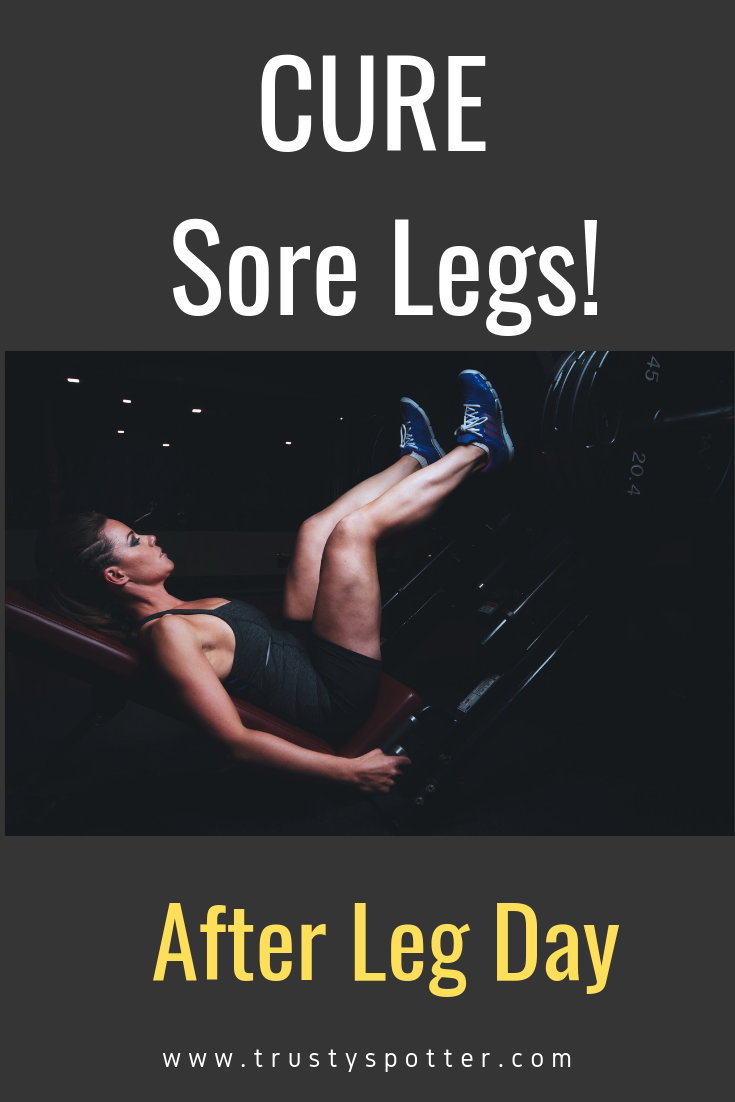Leg day, am I right?
For most of us, it’s not exactly our favorite day of the week. (Or 2 days… or 3 days… depending on your program.)
Your legs can handle a lot of weight, and so when you’ve really pushed yourself, they end up SUPER SORE.
And unlike having sore arms or shoulders, sore legs means you can often barely walk after squats or a leg workout.
So if you can’t walk after a leg workout on a regular basis, you’ve really got to invest some time in getting this problem fixed — unless you’re cool with waddling around in pain half the week!
The key to a pain-free leg day is proper warm-up, good form, and solid recovery. But we’ll go into a little more detail below.
Here are my favorite leg day recovery (and pain prevention) tips if you find you’re sore and can’t walk after leg day.

The reason you’re so sore you can’t walk after a leg workout is because our legs, due to the size of the muscle groups and the nature of the workouts, are more prone than other body parts to extreme or severe DOMS (Delayed Onset Muscle Soreness).
The key to prevent and recover from this soreness is staying active! Work your lower body regularly to adapt to the stresses of squats and deadlifts, and use active recovery like walking, foam rolling, or cycling to flush fresh blood into those sore muscles the day after leg day.
Let’s learn more about what causes severe DOMS after leg workouts and the best ways to prevent and recover.
Why do you get so sore after leg day?
We know that our muscles get sore when we work them hard, whether that’s through lifting heavy weights, doing tons of reps, or burning them out through long or intense cardio.
That’s not exactly a secret.
But why do legs get more sore than your other muscles?
The simple answer is that there are many muscles in your legs, and they’re quite large… which means it’s a lot harder for them to recover.
(Smaller muscles like abdominals and biceps, for example, can recover much faster.)
But let’s break down the actual mechanisms of muscle soreness.
The first kind of muscle soreness is acute, or immediate soreness.
This one is simple and pretty self explanatory.
As you challenge your muscles, they build up something called lactic acid, which is what causes the familiar “burning sensation” you get right before your muscles fail.
It’s this quick onset soreness that you feel in the gym, between sets, or right after you finish your workout.
It typically won’t last more than a few minutes, or at worst, a few hours after you finish working out.
To recap quickly:
-
You can sometimes get sore muscles immediately after or during a workout
-
This is called acute muscle soreness
-
It’s caused by a build up of lactic acid in your muscles (burning sensation)
-
Usually goes away fairly quickly
The second kind of muscle soreness, and the kind that can make leg day miserable, is delayed soreness, or Delayed Onset Muscle Soreness (DOMS)
DOMS is, well, exactly what it sounds like, and it explains why your legs are so sore the next day (or even two days) after a tough leg workout.
On a physiological level, the process of lifting weights and building muscle is quite brutal:
Lifting heavy weights literally causes microscopic tears in your muscle fibers. When these tears are repaired through rest, nutrition, and recovery, you build new muscle and gain strength.
But in the meantime, it hurts like hell! The micro-tears in your muscles will swell, become inflamed, and cause you some pain while they’re recovering.
To recap DOMS:
-
After really hard workouts, you’ll likely be at your most sore one or even two days later
-
This is especially true if you’re a beginner! First time leg workout pain is very common
-
Legs have especially brutal DOMS because the large muscle groups take longer to recover and heal
-
Micro-tears in your muscle fibers are agitated and sore while they heal, that’s why it hurts
Hear it straight from the experts:
I wanted to paint a fuller picture of leg day soreness, so I reached out to some trainers and fitness professionals to see what they had to say.
Robert Herbst, personal trainer and 19-time World Champion powerlifter
Robert says it comes down to people’s legs just not being used to the intense stress of weightlifting.
“People get more sore after leg day because they live sedentary lives and then lift heavier than they do on upper body days,” he says.
“People sit too much in front of the computer, in the car, watching TV, etc. Thus their legs are not used to a lot of use and heavy loads and stretching motions.”
“When they work legs, their muscles thus suffer more microtrauma so they get sorer, ” he adds. “To prevent this, they should try to be more active. They should also stretch on a daily basis to improve flexibility and range of motion.”
In other words, the best offense is a good defense! Stay active on rest days and work on your stretching and mobility to decrease soreness after heavy leg workouts.
Tim Liu, online fitness and nutrition coach
Tim pins intense DOMS in your legs on the size of the muscle groups used and the amount of weight people tend to lift on leg day.
“You’re usually lifting much more weight with your legs than, say, your biceps. Your legs are also a big muscle group and you use them all the time, which explains why the DOMS is so severe after,” he says
“Some ways to help with soreness is to foam roll your legs the day after, going for a long walk, or doing some light bodyweight exercises such as squats and lunges to get blood flow to the area.”
Erin Motz, NASM Certified Personal Trainer and yoga teacher at Bad Yogi
Erin says a little yoga might be just the thing you need to warm up, limber up, and reduce soreness from leg day.
“A lot of ‘leg’ exercises recruit other body parts,” she says. “Deadlifts and squats are leg focused but use the entire body.”
So what to do? Warm up your entire body before jumping into heavy weights — AND make sure you stretch to cool down after.
“Dynamic warm-ups like a few basic sun salutations and cat/cow are great as are more static holds in downdog, seated forward folds, and poses like triangle & pyramid.”
Tips to walk normal after leg day (and prevent or alleviate severe DOMS)
So now that you understand a little bit of the science behind leg soreness, you know that it’s totally normal!
(Yes, it’s normal to have trouble walking or be so sore you can barely stand or sit.)
Painful DOMS is usually a sign that you busted your ass in the gym and that major gains and toned legs are on their way.
However, it kind of sucks when you have to waddle around after leg day, limp down the stairs, and wince in pain when you try to sit down.
So there are a few things you can do before, during, and after your leg day workout to help make your life a tiny bit easier.
1. Warm up properly
Working out with cold or stiff muscles is a recipe for disaster.
Not only are you more likely to get injured doing this, you’re also way more likely to be super sore afterwards.
Before jumping into your heavy squats, deadlifts, lunges, etc. consider doing a little light jogging or incline walking on the treadmill to loosen up your quads and hammies.
Get your blood flowing and your muscles warm!
It’s also a good idea to properly ramp up to your work sets, doing a few sets with just bodyweight or much lighter loads to accommodate your body to the movement pattern before you start really taxing your muscles.
2. Hydrate like crazy

This is just generally solid life and health advice, but it counts double for recovering from leg day.
Make sure you hydrate plenty before, during, and after your workout, as well as in the days following it while you recover.
Proper hydration helps your muscles heal and helps deliver nutrients to the parts of your body that need it the most.
There’s no hard and fast rule for this, but you’ll sometimes see health experts recommend the 8×8 approach — that’s eight 8 ounce glasses of water every day.
But you can also calculate it based on bodyweight.
According to Good Housekeeping:
-
Take your bodyweight in pounds and divide by 2.2
-
Multiply that number by 40 (if you’re under 30), 35 (if you’re 30-55), or 30 (if you’re 55+)
-
Divide by 28.3 to get the number of ounces of water you should drink every day.
It sounds complicated, and it’s probably a little bit of overkill!
Just make sure you’re drinking plenty of fluids, and crank up the consumption around leg day.
3. Use better form during your leg workouts
Leg soreness is bad enough on its own. You really don’t want your back, knees, and other joints to be hurting, too, because your form is bad.
Take some time to correct your form, especially on your heaviest lifts like squats or deadlifts.
(These heavy compound movements have a LOT of nuance to the form that you need to nail as you learn to handle heavier and heavier loads.)
Find some form videos online (one of my favorites for the barbell squat is below) and study them to fix issues that may be holding you back from more gains, or that may be contributing to soreness in your knees or lower back, for example.
You should also consider filming yourself while you workout and watching it back later to spot form issues that could be making you more sore after leg day.
4. Stretch out those quads and hammies!
We talked about the importance of properly warming up, but just as important (and probably even more likely to be skipped) is a good cool-down session.
I know I am EXTREMELY guilty of this. After I lift heavy, I’m exhausted and ready to get the heck out of the gym.
But if you’re having major leg soreness or trouble walking, it’s probably going to be worth taking a few minutes to stretch after your leg day workout.
You don’t have to do anything crazy here, just get a nice deep stretch on your major leg muscles before you pack up and head home.
Make sure you hit your quadriceps and hamstrings, for sure, as those are big muscle groups that will hurt like hell if you don’t treat them well after a heavy lift.
5. Hit the stationary bike the next day
Once you’re in recovery mode (after your leg workout for the next two days or so), you’ll want really good blood flow so your muscles can get the nutrients they need to recover.
So even though you might be in pain, sitting on the couch doing nothing is probably not the right way to go.
Getting back to the gym, if possible, and doing some light resistance work on the stationary bike is PERFECT for leg recovery.
It’s low impact, easy, and will promote great circulation.
It might hurt at first if your legs are really sore, but it should help alleviate the pain sooner than hiding out at home would!
6. Walk through the pain

Similarly, you could go for a long walk to loosen those leg muscles up the next day.
You’ve heard of “the hair of the dog that bit you?”
It’s kind of like how the absolute last thing you want when you’re hungover is alcohol, but a little bit of beer or a Bloody Mary or something can really take the bite out of your headache.
When your legs are stiff and in pain and you feel like you’re dying, the last thing you want to do is walk around, but it might be just the thing to loosen you up and get your lower half feeling better.
It’ll suck at first, but it should help you recover.
7. Ice those legs down
If you’re having a seriously brutal leg day hangover or finding that your legs are giving out the day after a workout, it’s because you did some serious damage to your muscles on a microscopic level. (Congrats on a great workout!)
But as we talked about above, those little tears and abrasions are going to swell up and hurt like hell.
So what do you do when something swells up? You ice it down!
An ice pack on your legs will actually narrow the blood vessels and reduce the blood flow to the area, which will help the swelling go down and get you back on your feet.
8. Take an over the counter pain killer
If your quads are really killing you, you might want to consider taking the edge off with some Advil or Tylenol.
But is Advil or Tylenol better for sore muscles?
Both will probably work for the pain, but Advil (ibuprofen) is usually better for inflammation and muscle soreness, whereas Tylenol (acetaminophen) is better suited to headaches and the like.
Don’t overdo it, though, and start using pain killers as a cure-all for leg day soreness.
Every once in a while is OK if you really pushed it in the gym, but focus on better warm ups, cool downs, and recovery before you go relying on drugs.
Note: There is some evidence that anti-inflammatory drugs can inhibit muscle growth, so proceed with caution.
9. Use a foam roller

Foam rollers are a FANTASTIC accessory that can help you work out knots in your muscles, improve mobility, avoid injuries, and have better recovery after workouts.
Here’s a great resource with some awesome foam rolling exercises you can do after leg day.
When all else fails and the soreness is just too deep in your muscles, and you’re having trouble walking, using one of these bad boys can really help loosen you back up.
And if you’re looking to pick one up, here’s my favorite all-around foam roller on Amazon.
10. Use a high-quality BCAA (branch chain amino acids) for recovery
Sometimes, a high quality workout supplement can make a world of difference.
And if you’re having trouble with serious leg DOMS, a recovery formula like you’ll get in a BCAA might really help.
These essential amino acids aren’t created naturally by our body (we usually get them through food), but they play a massive role in turbo-charging protein synthesis after a workout, aka muscle recovery.
In other words, your muscles will heal and feel less sore much faster.
There are a lot of different ways to “load up” on BCAAs, but a simple way to do it is to make sure you’re getting around 10g per day, often before your workout for optimal performance and recovery.
Here’s a really great BCAA formula on Amazon to get you started.

11. Quit ego lifting
Finally, it’s possible that you’re just pushing yourself way too hard during your leg workouts and you’re paying the price for it.
If you’re working with weights you can’t really handle… yeah, you’re going to be sore.
If you’ve tried all of the above and you still find you can barely walk after leg day, it might be time for a deload.
Drop your squat weight (or lunges or whatever your program calls for) by 10-20% and take some of the load off of your muscles.
You can work your way back up quickly when you’re ready, but this should help some of the soreness in the meantime.
Wrapping Up
See, leg day doesn’t have to be a nightmare!
It’ll always be tough. After all, your legs can handle a lot of weight, and there’s something very taxing about heavy squats, deadlifts, lunges, etc.
But with a little preparation and planning, you don’t have to limp or waddle around after your leg workouts. There are other ways to live!
(Bonus tip: I didn’t mention it above because I didn’t want to suggest altering your workout program, but there’s definitely anecdotal evidence that if you actually train your legs more often, you’ll get less sore.)
I hope this has helped! And let me know in the comments your favorite leg day recovery hacks.

"Take your bodyweight in pounds and divide by 2.2
Multiply that number by 40 (if you’re under 30), 35 (if you’re 30-55), or 30 (if you’re 55+)
Divide by 28.3 to get the number of ounces of water you should drink every day."
Just simplify the math…
BW*0.64 (under 30)
BW*0.56 (30-55)
BW*0.48 (55+)
I guess whoever works at Good Housekeeping isn’t so good at middle school math…